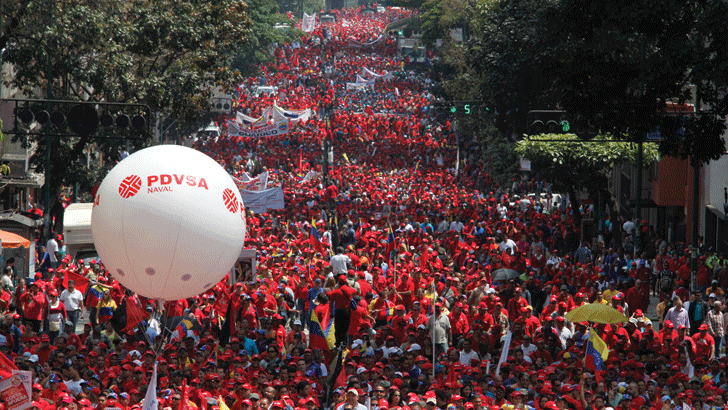Venezuelans stand up to right wing offensive

The victory of the late Hugo Chavez Frias in the 1998 presidential elections opened a new phase of working class struggle in Venezuela.
Since Chavez’s death last year, new President Nicolas Maduro has continued with the Chavista agenda. Consistent mass mobilisations of the working class, in some cases exceeding more than 1 million people, have made it clear that any attempt to overturn the gains of the Bolivarian revolution will not be easy.
There is much confidence among the working class, who continue to call for a deepening of the revolution, such as the recent call by auto workers for nationalisation of the industry. But in recent months, the country’s wealthy elite and the political right have been mobilising to create turmoil and attack the government and its supporters.
Eva Golinger, editor of Correo del Orinoco, has provided one of the best summaries of the current political situation, writing on 20 February: “The youth taking to the streets today in Caracas and other cities throughout the country, hiding their faces behind masks and balaclavas, destroying public buildings, vehicles, burning garbage, violently blocking transit and throwing rocks and Molotov cocktails at security forces are being driven by extremist right wing interests from Venezuela’s wealthiest sector.
“Led by hard line neoconservatives Leopoldo Lopez, Henrique Capriles and Maria Corina Machado – who come from three of the wealthiest families in Venezuela, the 1% of the 1% – the protesters seek not to revindicate their basic fundamental rights, or gain access to free healthcare or education, all of which are guaranteed by the state, thanks to Chavez, but rather are attempting to spiral the country into a state of ungovernability that would justify an international intervention leading to regime change.”
There has been speculation in the international media that the student-led protests are part of a democratic movement to overthrow the repressive government of Nicolas Maduro. Nothing could be further from the truth.
The attempt by the right to destroy the last 15 years’ social gains has been relentless, including the 2002 kidnapping of Hugo Chavez and installing of a US-backed regime. Due to the mass mobilisation of the working class and a section of the army remaining loyal to the Bolivarian process, that coup was defeated within 48 hours.
Other attacks by the ruling class have included lockouts of workers and organised shortages in food and services through sabotage and hoarding. Though the government has control of the oil industry and has increasing control of services and industries such as electricity, telecommunications and manufacturing, the private sector under opposition control can still create enormous problems in the economy.
The recent protests began on 12 February and have continued mainly in the eastern region of Caracas and other strong opposition areas around the country. Tamara Pearson, a socialist activist who has been living in Venezuela since 2007, says that some of the protesters may be students, “but they aren’t fighting at all for the student cause … [T]heir aim is to get Maduro to resign, through a war of attrition.”
A central aim of the protest is to create an atmosphere of fear and anxiety among the population. “Their cause has been supported by a few large, peaceful opposition marches in Merida, Caracas, and around the country, but overall the strategy is pure intimidation and psychological and violent soft war”, says Pearson.
The December municipal elections were the first real test of the Bolivarian process without Chavez, and thus the opposition saw them as a chance to make inroads. However, its vote did not increase, so it resorted to other means to topple the government.
“Even in the best of times, it is hard for [the opposition] to win an election, so sectors are looking at other, non-democratic methods. It’s also about those far right, undemocratic sectors seeking to gain the upper hand”, says Pearson.
However, the current protests have divided the opposition, with some arguing that now is not the time to make the push for regime change.
In 2002, the opposition had support within the military. But since then the Bolivarian revolution has made major changes to the military’s structure, personnel, training and education.
Pearson argues that it is unlikely that sections of the military would split away and join the opposition, but “It’s hard to know what’s going on behind the scenes. One general has been found to have been training the violent opposition. But once that’s come out, their career is over.”
What is clear is that the United States administration supports the current unrest and is encouraging destabilisation attempts by the opposition. However, the Bolivarian forces have learnt many lessons from their own experience and those of Chile 1973. It’s clear that they will continue to mobilise in their millions to protect the gains of the revolutionary process.